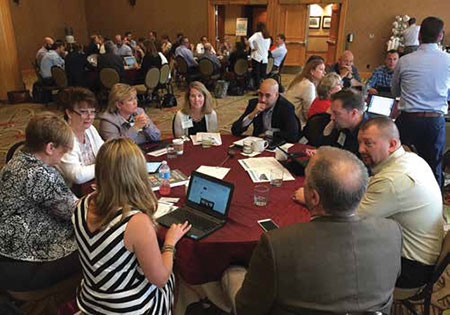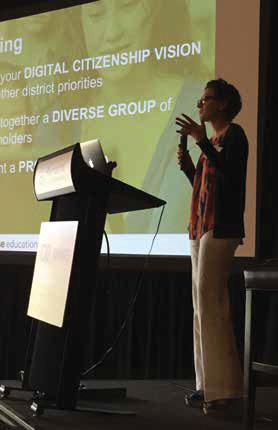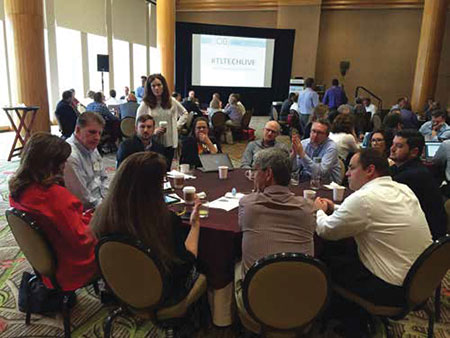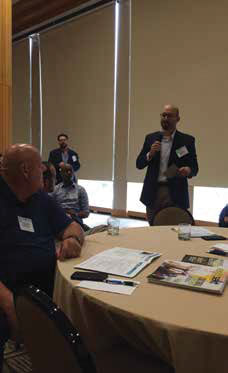SCHOOLCIO REPORT: FOSTERING DIGITAL CITIZENSHIP: A SCHOOL DISTRICT’S ROLE

Too often, schools focus only on the students when it comes to developing district Internet protocols. Administrators sometimes realize too late that teachers, staff, parents, and school board members are also in need of training. How can school executives create clear processes and procedures that will keep their districts out of the headlines?
The June 2016 SchoolCIO Summit, held in Denver just before the ISTE convention, focused on these questions and worked to create specific policies and procedures to educate school communities on their roles in the appropriate use of social media—not to limit or ban these powerful tools, but to harness their power in positive ways. Some of the attendees at this invitation-only conference already had digital citizenship action plans in place; many more did not. During the intensive two-day program, attendees worked in teams to create action items that they could put into place in their districts, affecting a combined total of more than one million students.
A CONVERSATION WITH ISTE AND COMMON SENSE MEDIA
T&L Content Director Kevin Hogan interviews ISTE’s Brian Lewis and Common Sense’s Jim Steyer. The summit began with a conversation. T&L Content Director Kevin Hogan interviewed Common Sense Media CEO James Steyer and ISTE CEO Brian Lewis. Steyer talked about the need to keep the dialogue—with parents, teachers, students, and other members of the school community—positive while addressing the hard issues. “We don’t want to lead with fear or censorship,” he said, “but sometimes a little shock and awe is needed to alert people to the dangers. Technology, used wisely, is a phenomenal tool that can transform learning, but used inappropriately it can have an enormously negative impact on kids." Examples that he shared (and that are highlighted in videos created by Common Sense Media for the general public) include sexting, cyberbullying, online porn, privacy violations, and the newer phenomenon of digital addiction.
Lewis, who had recently returned from a meeting at the White House on the bullying of Muslims, Sikhs, and other minority students, discussed the importance of engaging parents and community members in discussions about bullying and respecting one another’s differences. Such issues predate the Internet, of course, but technology can amplify their negative impact. On the other hand, as Jim Steyer pointed out, “One gift of technology is that it can be a platform for a larger conversation. For example, it’s sometimes hard for parents to talk directly to their kids about difficult issues but a movie can help open the dialogue.”
Following remarks by Steyer and Lewis, summit attendees weighed in with their own experiences related to digital citizenship. Examples included:
■ Kirk Anderson, director of educational technology for the Denver Public Schools, explained that, even though individual schools in the district have an unusual amount of autonomy, appointing a district-wide Digital Citizenship Officer who reaches out to building leaders to support their educational efforts has been a positive move.
■ Heather Heater, who heads the IT department for the Canton City School District in Ohio, emphasized the importance of starting at the top. “Our superintendent made digital citizenship a priority,” she said, “and everything took off from there.”
■ Justin Aglio, director of innovation for the Montour (PA) School District, described the ways in which students in his district have been involved in educating one another—including radio programs and reality shows focusing on uses of technology, as well as a project to launch a time capsule to the moon with a message from this generation of students to future generations.
■ Chris Sherman, who manages the instructional technology specialists in the El Paso (TX) Independent School District, described a process that began with 10 technology specialists training leaders on individual campuses and that’s scheduled to culminate with all 85 district schools receiving Common Sense certification by early 2017.
CREATING A COMMUNITY OF GOOD DIGITAL CITIZENS—A SCHOOL DISTRICT’S ROLE
Attendees brainstorm a digital citizenship action plan. The following morning, the attendees broke into teams, each of which represented a “district.” Teams rotated around the following stations that focused on:

■ Digital Citizenship for your Staff (facilitated by Paul Sanfrancesco, Director of Technology, Owen J. Roberts School District [PA])
■ Digital Citizenship for your Parents (facilitated by Mike Ribble, Director of Technology, Manhattan-Ogden [KS] School District and author of the ISTE book Digital Citizenship in Schools).
■ Digital Citizenship for your Students (facilitated by Nancy Battaglia, Director of Technology, Skokie [IL] School District 68)
Teams spent 30 minutes at each station, sharing their districts’ stories and best practices as they related to a guiding question. Below are the highlights.
STAFF: When asked, “What PD are you giving to your teachers?” attendees shared practices that included:
■ Model responsible social media use. Have teachers/staff follow administrators on Twitter and observe (lurk and learn).
■ Include information about student data privacy.
■ Hold a boot camp with teachers about the integration of 1:1 devices in classrooms. One of the sessions could focus on ethics and encourage teachers to have discussions about the perceptions their own digital footprints are putting out to parents and students.
■ Explain the importance of keeping accounts separate (personal and school), including email accounts, Apple IDs, etc.
PARENTS/COMMUNITY: When asked, “What education are you providing to your parents?” attendees shared practices that included:
Common Sense Media’s Rebecca Randall facilitated the closing session. ■ Offer parent nights where information and strategies are shared and there are opportunities for conversation.

■ Post information to the district Web site. Include resources on cyberbullying, Internet safety, etc.
■ Host the movie Screenagers with moderators for Q&A. This movie focuses on ways parents can improve communication with their children on their uses of technology.
■ Bring in an ADA to discuss apps/Internet situations that are challenging for your area (focusing on awareness, not negativity).
■ Have the kids create their own educational materials, and use these same materials with parent groups to educate them about how their own children approach appropriate technology usage.
■ Work in partnership with your police department. Make sure you define the scope of the conversation so that it stays positive and does not focus on the negative.
■ Partner with a not-for-profit to provide computers to low-income families. Prior to receiving the computer, parents attend a series of educational programs on digital citizenship and technology use considerations for parents. Show parents the “dark apps”— the apps that look like one thing but are really something different.
■ Connect families. Since it can be difficult to get parents to attend traditional parent nights, build events where students share their experiences in panels. This format helps to build conversation topics for parents to engage their children on real-world/everyday topics at home.
STUDENTS: When asked, “What curriculum is in place at school?” attendees shared practices that included:

■ Adopt programs like Common Sense Media. Courses engage students at their age/grade level. Teacher-leaders embed these lessons into other curriculum, such as life skills courses.
■ Offer a “Digital Driver’s License” for kids. Customize access for students and parents based on the level of digital citizenship instruction they complete (as students absorb more skills/knowledge/expertise, they gain a higher level of access).
■ Offer badges for levels of proficiency on digital citizenship using programs like Credly.
■ Blend into freshman foundations classes. Incorporate Common Sense Media curriculum. Units built in Haiku LMS provide incentives for good behaviors.
■ Make time. In a perfect world, digital citizenship education would happen as part of everyday instruction, but there isn’t always time. One way to approach this in a 1:1 situation is to integrate digital citizenship lessons in the first few weeks/months as students use their devices. Be sure to incorporate measurable digital citizenship practices into rubrics and assessments.
■ Invite guest speakers to address staff and students about copyright, digital citizenship, etc. For example, invite employees from the local county court to talk to students about legal ramifications (without using “scare tactics”).
CREATING AN ACTION PLAN

In the day’s closing session, Common Sense Media’s Rebecca Randall facilitated a conversation among the teams, asking them to create the foundation of a digital citizenship action plan. Here were some key ideas:
STAFF:
■ Staff, students, and everyone constantly under surveillance.
■ Teachers who want to have their own social media presence must first “Friend or Follow” the district-owned social media account. This allows tracking.
■ Pre-service programs are not preparing future teachers properly for social media and edtech.
COMMUNITY:
■ Host parent meetings to discuss your district’s acceptable use policies. Parents want assurances that the school will keep their kids safe.
■ Using data helps identify what needs to be addressed and also helps build a marketing campaign.
■ Empowering students to make the right decisions and address problems.
■ Important to have students and parents take ownership.
■ Proof of skills and badging is more important than we think. Consider badging parents on their online (LinkedIn) profiles.
CLASSROOM:

■ Device search guidelines. If there’s material on a device that you believe is in violation of school policy, then you can ask to see the device. You would need to let the student know what you believe the violation is and what you will be looking for (specifically) before looking at the device, and you would only be allowed to look at what you say you’re looking for.
■ Make curriculum a digital “driver’s license.”
■ Teach students to have a positive online portfolio. Don’t always focus on the negative aspects of online activity.
■ Let certain students be in charge of what gets posted on Twitter and other online content.
■ Teach world citizenship, not just digital citizenship.
ASK A CIO: WHAT IS YOUR BIGGEST CHALLENGE AS CIO?
With all the budgetary issues in the K-12 space, it would be easy to give the stock answer that struggling to find dollars to sustain a relevant environment is my biggest challenge. Although that is [challenging], I feel the bigger challenge is maintaining support for our classroom teachers. Building and sustaining a professional development model that supports and empowers our teachers to build strong PLN’s, collaborate often, and share out, is difficult and always changing. Having time to focus on the technical side and the teaching side is rewarding, challenging, and a good problem to have.
—Jon Castelhano
Human resistance to change. That mostly comes from the union, but also comes from fearful, nervous administrators, parents, even students. Technology is often seen as a complex and frustrating requirement of modern life—as opposed to the tools without screens and batteries, which are seen as logical and helpful. If we apply the same logic, patience, and collaboration around learning to use a computer-based piece of technology, it isn’t any more scary than learning to use a wrench or a blender. Unfortunately, media has portrayed the laptop, tablet, and phone as auxiliary, young people’s tools, which makes the work of learning to use them that much more offputting for older adults.
—John Marcus
Knowing how to juggle multiple projects simultaneously. Also understanding the classroom environment. Being in the classroom and working closely with teachers, students, and school administrators is the only way to really understand the needs of the school.
—Joel Handler
Tech & Learning Newsletter
Tools and ideas to transform education. Sign up below.
